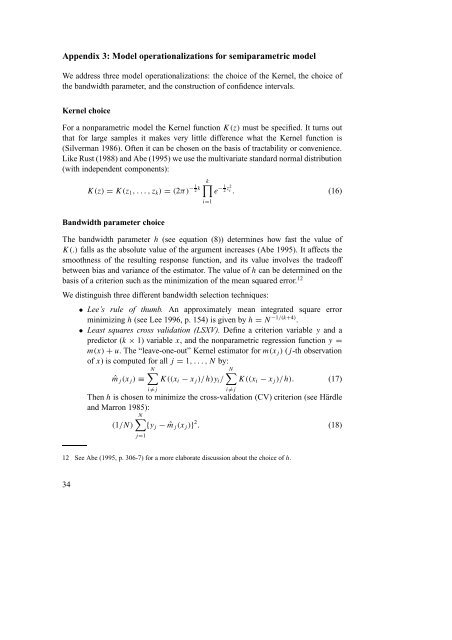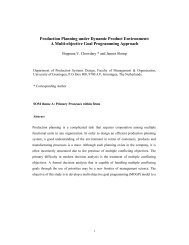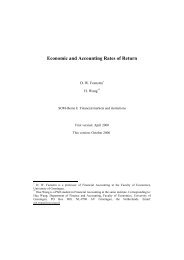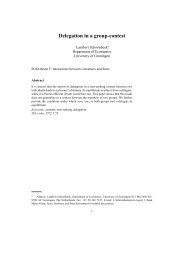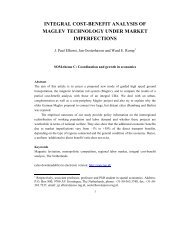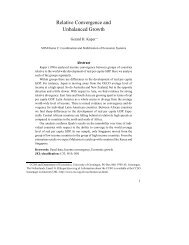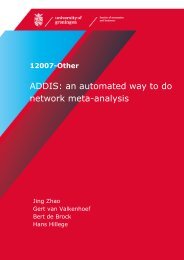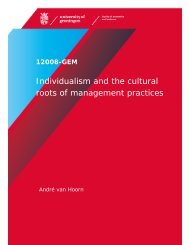Semiparametric Analysis to Estimate the Deal Effect Curve
Semiparametric Analysis to Estimate the Deal Effect Curve
Semiparametric Analysis to Estimate the Deal Effect Curve
You also want an ePaper? Increase the reach of your titles
YUMPU automatically turns print PDFs into web optimized ePapers that Google loves.
Appendix 3: Model operationalizations for semiparametric model<br />
We address three model operationalizations: <strong>the</strong> choice of <strong>the</strong> Kernel, <strong>the</strong> choice of<br />
<strong>the</strong> bandwidth parameter, and <strong>the</strong> construction of confidence intervals.<br />
Kernel choice<br />
For a nonparametric model <strong>the</strong> Kernel function K(z) must be specified. It turns out<br />
that for large samples it makes very little difference what <strong>the</strong> Kernel function is<br />
(Silverman 1986). Often it can be chosen on <strong>the</strong> basis of tractability or convenience.<br />
Like Rust (1988) and Abe (1995) we use <strong>the</strong> multivariate standard normal distribution<br />
(with independent components):<br />
K(z) = K(z1,...,zk)=(2π) −1 2k k<br />
e −1 2z2 i . (16)<br />
Bandwidth parameter choice<br />
The bandwidth parameter h (see equation (8)) determines how fast <strong>the</strong> value of<br />
K(.) falls as <strong>the</strong> absolute value of <strong>the</strong> argument increases (Abe 1995). It affects <strong>the</strong><br />
smoothness of <strong>the</strong> resulting response function, and its value involves <strong>the</strong> tradeoff<br />
between bias and variance of <strong>the</strong> estima<strong>to</strong>r. The value of h can be determined on <strong>the</strong><br />
basis of a criterion such as <strong>the</strong> minimization of <strong>the</strong> mean squared error. 12<br />
i=1<br />
We distinguish three different bandwidth selection techniques:<br />
• Lee’s rule of thumb. An approximately mean integrated square error<br />
minimizing h (see Lee 1996, p. 154) is given by h = N −1/(k+4) .<br />
• Least squares cross validation (LSXV). Define a criterion variable y and a<br />
predic<strong>to</strong>r (k × 1) variable x, and <strong>the</strong> nonparametric regression function y =<br />
m(x) + u. The “leave-one-out” Kernel estima<strong>to</strong>r for m(xj) (j-th observation<br />
of x) is computed for all j = 1,...,N by:<br />
N<br />
N<br />
ˆmj (xj) ≡ K((xi − xj )/h)yi/ K((xi − xj )/h). (17)<br />
i=j<br />
Then h is chosen <strong>to</strong> minimize <strong>the</strong> cross-validation (CV) criterion (see Härdle<br />
and Marron 1985):<br />
N<br />
(1/N) {yj −ˆmj(xj )} 2 . (18)<br />
j=1<br />
12 See Abe (1995, p. 306-7) for a more elaborate discussion about <strong>the</strong> choice of h.<br />
34<br />
i=j


